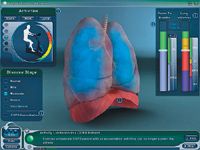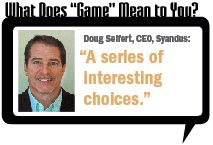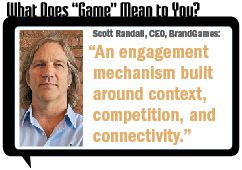Gamification Grows Up
Pharmaceutical Executive
Early efforts in the pharma space to harness the engagement factor in game technology focused on delivering a fun experience, with a tackedon educational component. Today's games bring behavior change to the forefront, incorporating social dynamics, mobility, and increasingly sophisticated mechanics.
Companies using game mechanics to encourage specific patient behavior is not a new phenomenon within Big Pharma—a surprising conclusion given that the industry tends toward the walker's lane in the race to apply hard technology to the art of marketing and promotion. But the game is changing fast, driven by two major changes in the way technology can be applied to broaden the patient experience in healthcare. These are the widespread adoption of mobile devices with computer-strength processing power and graphics, and the participation of nearly everybody in one online social network or another.

Stockbyte / Getty Images
On top of that, game developers have learned how to control costs and address the issue of scale by anticipating precise needs in the market, like training reps or illuminating biological systems for physicians through simulation; targeting a condition or disease state and the already-existing behavior set of those patients; or creating an emotional response to facilitate learning around specific tasks. By building technology platforms, agencies don't have to start from scratch with each new game, which can quickly get prohibitively time consuming and expensive.
To examine the evolution of gaming in the healthcare space—what companies are doing now, where things are going, and why—Pharm Exec spoke with three gaming agency CEOs about the programs they've developed for Big Pharma clients, and their approaches in general to engaging physicians and consumers using game technology.
Change...or else
Doug Seifert, CEO at Syandus, a small experiential learning agency in Exton, PA, says "learning by doing" is the most effective way to absorb complex concepts. One of Syandus's projects, created for two large pharmas that co-promote a drug for chronic obstructive pulmonary disease (COPD), is a simulation tool that lets physicians explore the disease with unprecedented interactivity. COPD is complex, and often patients—and their physicians—don't fully understand the consequences of certain behaviors.
With the COPD simulation, physicians can control a virtual patient (which can mirror an actual patient through the insertion of medical record information), and tweak environmental variables to see how that patient might respond, on a deep physiological level. A physician can introduce a drug therapy, or even change the number of cigarettes a patient smokes per day. This kind of playfulness by a physician provides a stronger knowledge of the disease, and it also facilitates a more valuable exchange during a patient consultation.

Syndus's COPD simulation lets physicians interact inside the disease environment.
Specifically, physicians have used the simulations to help patients visually understand how behavior affects their health outcome. Take smoking, for example. "It's hard for a patient to really understand what's going on in their lungs, but when you go into the [simulation environment] and see a cross-section of what's happening when you breathe—here's the constriction that occurs—it helps to create a very vivid image of, 'this is where you are, and if you keep smoking it will get worse, so let me show you where it's going.' Being able to demonstrate disease progression visually is very important," says Seifert. The COPD simulation program isn't really a game per se, but it employs game technology, by allowing physicians to make choices and see the results of those choices.

Physicians can demonstrate to patients how smoking exacerbates COPD.
Seifert calls simulation an example of "serious games," which differ from games constructed around missions, which the player traverses through failure. "Try this over and over again and you'll eventually get it—that's not really effective from a learning perspective," says Seifert. "Casual games for learning is the edutainment model; kind of fun, and you play around and learn a few things along the way, but it's not built around how can we help a learner understand this concept using this technology. That's a different twist and it's harder, but the results are spectacular."

Syndus's simulation interface tool.
Impact on outcomes
Speaking of results, what are the key performance metrics on a program like this? "ROI and how you measure it is always an important aspect...sometimes you can't tease out the exact lift [in prescriptions sold], and you need control groups," says Seifert. "But we can measure where the physician is, how many access the simulation, how long they were on it, where did they spend their time, how far did they go, et cetera," and then those analytics can be combined with in-house claims data and the like, to measure results.
If these kinds of metrics get frowns from upper management, Seifert says it's important that companies understand that for complex diseases and best clinical practices, videos sometimes aren't enough. "A simulation program creates value for customers, and if you leverage it broadly, measure the results, and earn respect through providing real clinical value, then selling the brand becomes a lot easier," he says. "For these programs to be successful, they have to be positioned as part of the fabric of the company's brand strategy, not just a tactic subject to budget cycles." Seifert says the technology's "wow-factor" has staying power, citing a client that's been using one of the programs for over five years.

To get access to the simulation, physicians receive a link and a code, which can go out in professional marketing materials (reps can hand out a "web code card," for example). The program is self-contained online so physicians can access it anywhere. Codes can also be placed in journal articles, says Seifert, underscoring the educational element.
Learning by doing
Seifert's philosophy on learning, which is the catalyst for behavior change, is based on the idea that "human beings are pattern recognition machines," he says. "We learn by recognizing those patterns and new experiences, and they can be virtual experiences or not. We link those patterns to our existing patterns, and that's how we learn. If you look at didactic learning—the lecture format—it's linear, and it has been demonstrated to have low retention levels. Learning by doing results in higher retention rates, because you're placed in a situation where you need to make choices to achieve a specific outcome, whether those choices are in a virtual environment or a real environment, and then you learn what patterns lead to the desired outcome. This is powerful, and it works whether you're a physician trying to do a differential diagnosis and come up with the appropriate treatment plan for a specific patient history, or if you're trying to do an analysis of the patient situation. The same holds true if it's the patient trying to improve her health. I think that's the value and attraction of this learning tool."
Dunbar's number
From Syandus's we move to Vancouver, British Columbia, where Michael Fergusson works as CEO at Ayogo, a four-year-old shop that employs 30 people. The number of employees is important to Fergusson. His agency's work is founded on the principles of Robin Dunbar, a British anthropologist and evolutionary psychologist. In his research with primates, Dunbar concluded that the number of relationships any one gorilla (and human, implicitly) can sufficiently maintain, or "groom," in Dunbar's parlance, is finite. In short, when troops of silverback gorillas grow to a certain size in the wild, they inevitably splinter into smaller groups, because only a certain number of relationships between gorillas can be properly groomed. From this research came "Dunbar's number," which is roughly 150 (more precisely, it's 148, Fergusson notes, with 150 representing the tipping point).

Aygoto's Tamagotchi-style game rewards kids for checking their blood sugar. In-game currency builds with desired behavior.
Dunbar's number was popularized by the author Malcolm Gladwell to illustrate the limitations of large teams or organizations. "When a company gets to be about 150 people, it should really start thinking about being two smaller teams. Neolithic farming villages, the size of the Roman legions...these were all around 150 people," says Fergusson. There are only certain kinds of information that a person will typically share with 150 people, however, and there are other kinds of information that is only shared in smaller, intimate groups of between four and 12 people. What does all of this have to do with gamification in pharma? Potentially a lot, it turns out, if brands are interested in leveraging social connections to reinforce behavior change.
Peer group effect
Ayogo's business model is to partner with non-profit organizations and have a pharmaceutical sponsor underwrite the game development. That allows the games to be given to patients for free, a point of importance for Fergusson. A current project was created in partnership with the Diabetes Sisters Foundation, an advocacy group for women with diabetes, and funded by Sanofi. Called SisterMatch, the game was developed for women between the ages of 40 and 60 years old, with type 2 diabetes. "Often these women feel very isolated," says Fergusson. "Many have developed sophisticated coping skills, with good ways to manage their condition, and some others have not. What the research tells us and we accept as true is that people who have strong relationships with other people who have diabetes—strong peer groups—are more successful in staying healthy. The behavior change we want is for these women to find each other, and to exchange information about their lives and about managing their disease, and to provide each other with practical and emotional support."

The target group for SisterMatch, unlike teenaged boys, doesn't like to fight and compete; they like to cooperate, says Fergusson. Thus, the game needed to be built around the dynamic that leads to cooperation within this group.
As it turned out, that dynamic was the telling of embarrassing stories. "Women love to do this, you see them all standing together, and someone says, 'this really embarrassing thing happened to me.' And they all bond around it," says Fergusson. "So we built [SisterMatch], an application in the form of a quilt. It's a cooperative game, and together the objective is to build a quilt, and each square represents a story that's told by someone in the community. Others can comment on the quilt, and make connections." Squares on the quilt are the game's reward, and there are quizzes that provide additional ways of initiating new conversations. "We might also give the community a mission, for example, we want them to try going to bed earlier to see how that affects the way they feel," says Fergusson. "We could just say 'go to bed earlier,' but it's much more effective if we say, 'go to bed earlier three times this week, and then come back and tell us how it affects your sex life.' That turns out to really work."
The game also has "an eHarmony-like personality matching system, so that when you visit your quilt, the other people's quilt squares nearby are people whose personalities most closely match yours. So you're more likely to find people you can relate to, who have similar interests, and live in similar geographies," says Fergusson. Dunbar's research helped Ayogo determine the optimal group sizes for cooperation and sharing, which is one reason the game isn't on Facebook, for example. "Facebook is not a good social network environment for transmitting behaviors of certain types," particularly when the focus is on making changes around intimate health and medical areas, according to Fergusson.

SisterMatch facilitates social connections between senior women.
Another game called Small Things, also funded by Sanofi, is currently in the beta testing phase and is designed for families with children diagnosed with type 1 diabetes. It's tough on kids to have to get up and leave the classroom to test their blood sugar every day, and the real kicker of it, says Fergusson, is that if the child does the right thing, dutifully pricking a finger and recording the result, nothing happens. Things happen—negative things—when they don't follow the rules. "Our brains are designed to respond to something, not nothing, even if that thing is negative. Small Things is a smartphone app, and it works around a Tamagotchi-style game (Tamagotchi is the hand-held digital pet that every kid wanted a few years back) for the child with diabetes. The app sends an alert when it's time for a blood test, and then results are typed into the app. The app transmits the data to the child's parents or caregiver, and the next thing that happens, before they leave to go back to class, is they get a notification announcing some earned game currency. Currency allows them to create little monsters and then nurture them. The monsters live in a world that the user can customize, and this play—which is only 15 to 20 seconds after the test—provides an award. Parents get the blood results, but also data on their child's participation in the game play, through access to a web interface, and they can also get it sent to their phones.
Small enough
From the web interface, parents can also communicate with other parents, because "that's the right time and place, when [parents] are online and thinking about their child, and have a question," says Fergusson. "That's done through a social network, optimized for small groups, and the parent can also push additional game play rewards into the monster environment for the child. "Susie is keeping her room tidy or taking care of her diabetes equipment, or doing a better job of eating on schedule. That might not be directly measurable, but the parent can reward the behavior they want to reinforce." Ayogo hasn't partnered with a non-profit yet for this game, but is in discussions currently, and Sanofi has an option to brand it and disseminate it to patients.

Asked about ROI and metrics from a pharmaceutical underwriter's perspective, Fergusson says some of the companies he works with are only interested in getting to the patient right when a treatment decision is being made, but others are more forward looking. "Something really interesting is happening in the pharma space...one by one, companies are coming to the conclusion that they don't sell pills, actually. Their business is getting people healthier. I want to engage with a company that I trust to help me manage my health, and if I do need pills, then it should be a company that I know can deliver them. But if all you can do is sell me pills, you're not part of my health solution or part of me living a healthy life."
Games that externalize fear
Emotions often run high when it comes to children and diseases. Scott Randall, CEO at BrandGames, an elder statesman of the gamification industry (BrandGames set up shop in 1995), recently did a project aimed at helping parents inject their kids correctly. That's a tricky task, particularly when the caregiver or parent himself is afraid of needles. "The risks involved in administering the medication are significant, and all patients get is this little box with a piece of rice paper in it, and it says, hold the syringe like this, put it together like this, do this, do that, and stick it in your kid's leg," says Randall. "They've never done this before, and now they have this hysterical child on their hands, and they're supposed to be administering the medication."
The idea for the game is built around the concept of a tutorial, with added emotion. "You match the different steps in the process and assemble an interactive syringe, and then you get coached on whether or not you've done a good job," says Randall. "There's a big-picture comfort piece for the caregiver or parent that says, you know, this is something you can do." The online tutorial discusses how the drug works, to help increase competency in administration at the same time. "It's really for the protection of the patient, because at the end of the day, a calm and confident caregiver projects that onto the kid, who can smell fear a mile away," says Randall. The key performance metric in this instance is based on a reduction of adverse events.
It's a learning game
For Randall, the key to developing games to modify behavior is time and engagement. "People don't have either. You have to get them engaged emotionally in what's going on, or they won't participate," he says.
BrandGames has also done healthcare training for a nursing program at Johnson & Johnson, and pharma rep training for Daiichi Sankyo. "The idea is, how do you engage the doctor and how do you engage patients? When you're looking at patient outcomes, you have to give the patient the big picture of what the medication is doing. At the doctor's office, you get a Xerox of a Xerox of a Xerox. You go home with no emotional engagement; you have no context around your treatment. Without that, patients don't participate in their treatment, and outcomes are worse," says Randall.
Taken together, the message emerging from Seifert, Ferguson, and Randall is that pharma companies looking to gamify their brands need to put education and learning up front, and figure out what specific behaviors are unique to the patient audience. Then decisions can be made about the appropriate gaming mechanisms to use, who to share with, and how to get it in the customers' hands.

Is Artificial Intelligence a ‘Product’? Products Liability Implications for AI-Based Products
April 10th 2025As the physical products we use evolve to become increasingly complex, traditional products liability frameworks may not always fit to provide remedies for harm that can result from using novel product types.